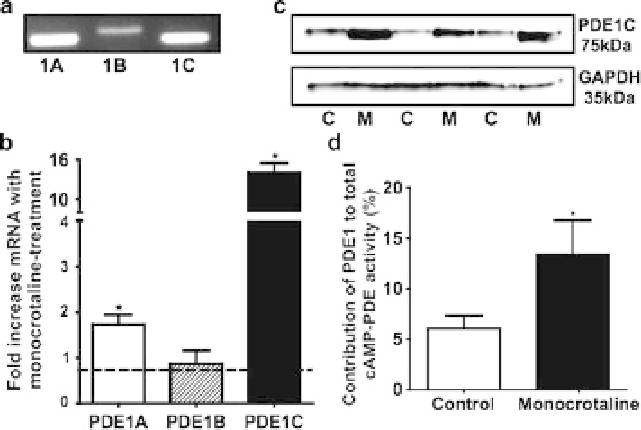Biology Reference
In-Depth Information
Fig. 3 PDE1 expression in rat lung and upregulation with PAH. (a) mRNA for PDE1A, 1B,
and 1C is detected in rat lung. (b) PDE1A and PDE1C mRNA, (c) PDE1C protein, and
(d) % contribution of PDE1 to total PDE1 activity is increased in monocrotaline-treated rat lung
(M) relative to control (C). PDE activity was determined using 1
m
M cAMP as substrate through a
two-step radioassay procedure (Keravis et al.
2005
; Thompson et al.
1974
). To identify the
contribution of activity of PDE1, we performed assays in the presence of specific PDE1 inhibitors
[30
m
M vinpocetine, 30
m
M 8-methoxy-methyl-3-isobutyl-1-methylxanthine (8-MM-IBMX)] and
with or without Ca
2+
/Calmodulin in the presence of EGTA.
n ¼
3, *
P
<
0.05 vs
.
control
0.33 mmHg mL
1
min
1
per
100 g of body weight) in the monocrotaline-treated rat and increased the portion of
nonmuscularized PA in the chronic-hypoxic mouse (Schermuly et al.
2007
). How-
ever, since both vinpocetine and 8MM-IBMX can inhibit other PDEs (in particular
PDE7 and PDE5, respectively), this could alter the interpretation of the data.
Due to the lack of specific pharmacological inhibitors for PDE1, no clinical trials
for PAH have been undertaken. However, vinpocentine (up to 40 mg per day) has
been used to decrease smooth muscle tone in the lower urinary tract for urge
incontinence and is approved and used in Eastern Europe to enhance cerebral
blood-flow and improve memory (Kemeny et al.
2005
; Truss et al.
2001
). Although
one must be cautious in drawing conclusions from such results, the studies suggest
that PDE1 inhibitors are generally well tolerated. Furthermore, PDE5 inhibitors
such as zaprinast and sildenafil interact with PDE1 (sildenafil has a IC
50
of 350 nM)
and 100 mg sildenafil can lead to a plasma level of 1.2
m
M, suggesting that
potentially some of the beneficial effects of “PDE5 inhibitors” in PAH may, in
fact, result from inhibition of PDE1 (Paul et al.
2005
). The data above highlight the
need to test selective PDE1 inhibitors since their use is crucial to define the function
of PDE1 and its potential as a therapeutic target for PAH.
Previous studies regarding specific PDE1 isoforms provide further evidence for
a role of PDE1 in PAH, a disease characterized by reduced sensitivity to vasodila-
tors and excess number and activity of smooth muscle cells. An increase in PDE1A
8MM-IBMX decreased PVR (2.14
0.26 to 1.32

